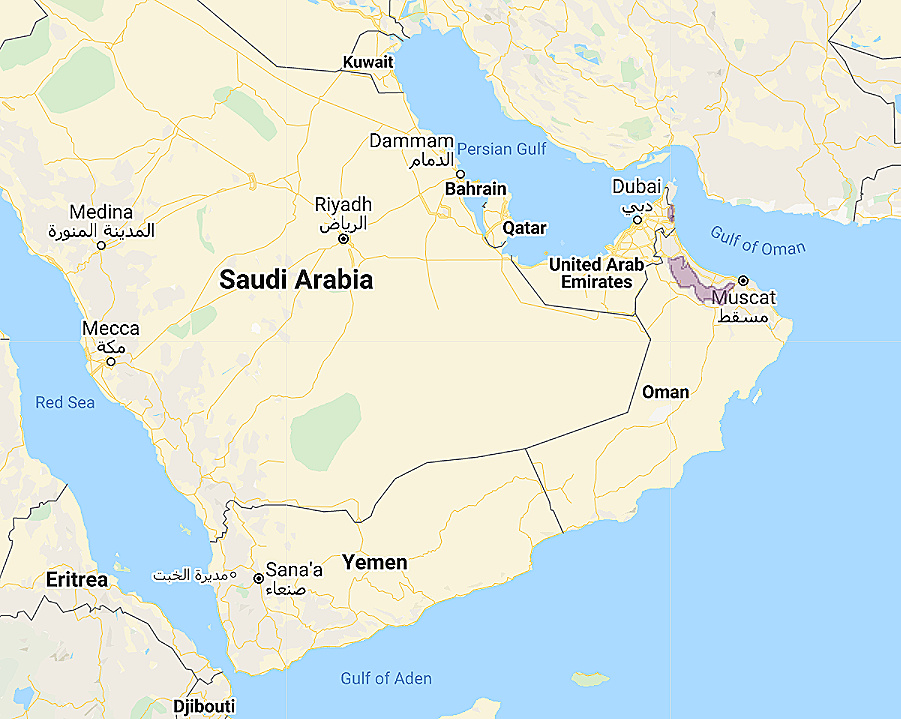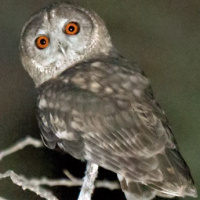Introduction
The Omani Owl is a medium-sized owl with a rounded head, no ear-tufts, long legs and a short tail.
Photo Gallery (2 pictures)
Sound Gallery
Information
Description: The facial disc is grey, with the darkest grey above the eyes forming distinct dusky "brows", and paler grey between
the eyes, around bill and on the chin. The distinct rim is blackish on the inside and whitish on the outside, with a dark streak broadly edged in white coming
down on forehead almost until between the eyes. Pupils are black, with each iris orange-yellow surrounded by black. Eyelids are black. Bill is pale green-grey.
The crown, nape, collar and throat is buff-brown with small blackish spade-shaped bars on the back of the head and blackish streaks on the throat.
Mantle, scapulars, back, rump and uppertail-coverts are dark grey-brown with buff and whitish spots.
The breast is buffish white with short longitudinal stripes. The whitish belly is not demarcated from the breast but is paler with longer thin blackish vertical
stripes. The flank is as pale as the belly with a few slightly thicker and longer longitudinal blackish stripes. The abdomen, undertail-coverts and thigh are
greyish white.
The wing remiges are greyish brown with pale bars. On the upperside, remiges are mostly dark brown, with broad dark brown bars and narrow pale brown bars and
top. Alula is dark brown-grey. The greater coverts are brown, the three outer ones have a large white spot near top. Median coverts are brown, two outer ones
also have a white spot near top. Lesser and marginal coverts are brown. Greater, median and lesser primary coverts are dark blackish-brown. On the underside,
remiges are whitish at the base and greyish at the top. From inside to outside of the wing there are dark bars becoming wider, rendering outer primaries largely
dark. The inner primaries are white at the base with dark bars becoming broader towards the top, while the secondaries are white with narrow
dark bars and a broad dark top. Greater, median, lesser and marginal underwing-coverts are greyish white. Greater
under primary coverts are blackish brown, median under primary coverts white, and lesser under primary coverts greyish white.
Tail rectrices are whitish with a white base on the underside and with two broad blackish bars caudally, equal in width to the white in between and on top, and
there are two vague narrow dark bars distally.
Tibia, tarsus and toes are feathered whitish. Claws are pale greyish.
Size: No size data available.
Habits: Unknown. Probably a generally nocturnal bird.
Voice: Calls are apparently quite variable, with several described.
A loud 4-note hoot, the first note is lower, the second rises slightly in pitch and the final two stay at or close to this higher pitch -
HU... HWA... ha-hA. A common variant has an additional, short and slightly lower-pitched note or occasionally two, after the last accented one, -
HU... HWA... ha-HA-ha(ha).
A pulsing sequence of hoots with a subtle rise and fall in frequency and intensity - hu-hu-hu-hu-hu-hu-hu-hu-hu-hu-hu-hu-hu.
The alarm call is a rapid series of fairly nasal-sounding barks, each with predominantly rising intonation. The contact call is usually a nasal, rising sound
- NYEP.
Hunting & Food: Unknown. Likely similar to other Strix owls.
Breeding: Unknown.
Habitat: Rocky cliffs.
Distribution: Al Hajar Mountains in northeastern Oman.

Range of the Omani Owl Strix butleri
Status: Unknown.
Original Description: Hume, 1878.




